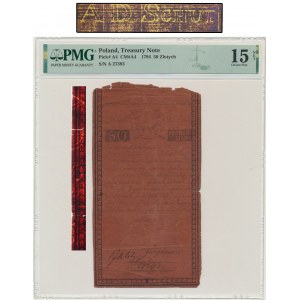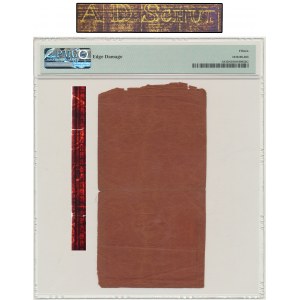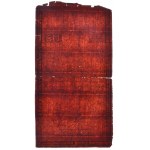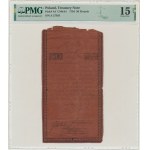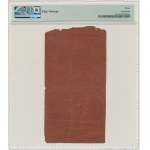A true rarity! Kosciuszko ticket printed on paper with filigrees of the extremely rare company A.D.SCHUT & C.
Quoting after Czeslaw Miłczak, "Kosciuszko Insurrection banknotes with watermarks (filigrees) of the Dutch companies Jan Kool & C. and A.D.SCHUT & C. are encountered extremely rarely - they are mostly 5-zloty bills. Reading these marks (inscriptions) is difficult, as they are often located on the border of the banknotes' slit."
This is no different in the offered case, where the inscription fragments of the filigree are visible on the edge of the banknote field. The piece on offer is a 50-gold denomination, and according to our observations, it is on this denomination that we can find the watermark of A.D.SCHUT & C., and on the 5-gold Jan Kool & C.
The banknote offered in the PMG slab with the PMG 15 NET grade. NET surcharge unjustified in our opinion, we see no reason why the banknote's state of preservation could deteriorate further, hence according to the new PMG methodology, the NET surcharge would not be awarded.
A natural piece, well colored with beautifully preserved red printing. Dry stamps legible, pleasantly convex. Granted a crude note, damage to the top edge is quite common with long tickets of the Kosciuszko Insurrection. It cannot be ruled out that some of the tickets were ripped out, instead of cut from the back part with the control number. The field of the banknote does not show a large number of fractures, and the fracture lines do not bear visible ink rubbing. Edges correct, only locally uneven and cut.
The offered banknote, is probably the first offered piece with the "caught" extremely rare A.D.SCHUT & C. filigree, but naturally it cannot be ruled out that in the past such pieces were listed but not described by the auction houses offering them. Awareness among collectors of Polish paper money of rare filigrees has been prevalent for a good few years, despite which we still have not seen their listing until the piece in question. We have been paying attention to filigrees for a long time, and according to us, based on conversations with advanced collectors of Kosciuszko tickets known in private collections, there are no more than 5 pieces that we can locate from private collections.
The Kosciuszko ticket that is the subject of the auction will be appreciated primarily by persistent collectors with many years of experience, but with the immense popularity of Kosciuszko tickets, we hope that junior collectors will also appreciate the occurrence of a ticket with such an extremely rare filigree. An uncommon item, an absolute rarity, the opportunity to purchase of which may not be repeated for a long time.
The source of the "A.D.SCHUT & C" photo is Cz. Miłczak, Polish Banknotes and Designs, vol. I, ed. 2023, p. 63.
In the Polish lands, the introduction of paper money into circulation was connected with expenses related to the outbreak of the Kosciuszko Insurrection. Its issuer was the Directorate of Treasury Tickets established by the Supreme National Council. In terms of value, treasury tickets were equated with coinage. Obligations to the Treasury could be paid a maximum of 50% in paper money and the remainder in coins. This condition resulted in its negative reception by the public. In the future, the redemption of treasury tickets was to be financed from national wealth. For counterfeiting paper money, the death penalty was stipulated, as well as confiscation of all the perpetrator's property. On September 29, 1794, in order to strengthen confidence in treasury tickets, the National Supreme Council authorized the regulation of the entire amount in paper pennies and zlotys. Due to the failures of the uprising, public confidence in paper money was declining. The population preferred to accept bullion money in settlements. The range of issuance of the first Polish paper money was small - it was introduced on a large scale only in Warsaw. After the capture of the capital on November 6, 1794, tickets of all denominations for a total of 7.8 million Polish zlotys remained in the hands of the population.
On June 8, 1794, the Supreme National Council passed a resolution establishing an issuing institution - the Directorate of Treasury Tickets - and introducing treasury tickets in denominations: 5, 10, 25, 50, 100, 500 and 1000 Polish zlotys. Treasury tickets with an issue date of June 8, 1794 are very similar. They are one-sided printings in the form of a standing rectangle differing only in color and border detail. Each denomination was hand-numbered and signed by two or three representatives of the Treasury Ticket Directorate. In addition, each ticket bears the dry seal of the Treasury Ticket Directorate.
After printing, paper money of equal denomination was stapled together in the form of a cloth-bound "booklet." When they were put into circulation, they were hand-cut from them by which tickets of the same denomination differed in size and in the shape of the top edge. The part that remains in the "booklet" and the coin released into circulation have the same number.
